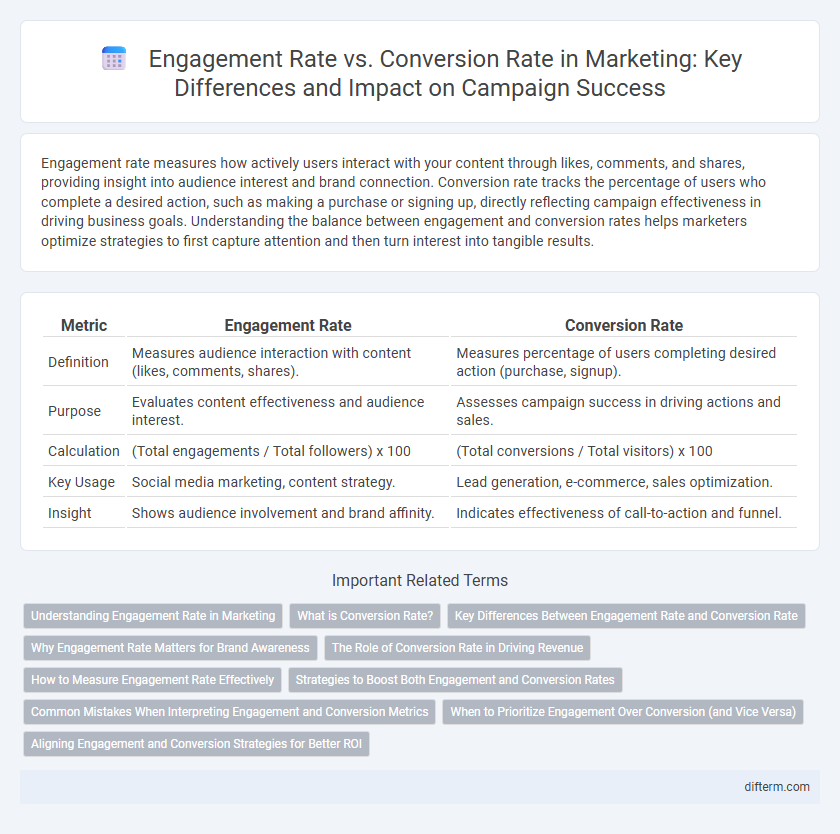Engagement rate measures how actively users interact with your content through likes, comments, and shares, providing insight into audience interest and brand connection. Conversion rate tracks the percentage of users who complete a desired action, such as making a purchase or signing up, directly reflecting campaign effectiveness in driving business goals. Understanding the balance between engagement and conversion rates helps marketers optimize strategies to first capture attention and then turn interest into tangible results.
Table of Comparison
| Metric | Engagement Rate | Conversion Rate |
|---|---|---|
| Definition | Measures audience interaction with content (likes, comments, shares). | Measures percentage of users completing desired action (purchase, signup). |
| Purpose | Evaluates content effectiveness and audience interest. | Assesses campaign success in driving actions and sales. |
| Calculation | (Total engagements / Total followers) x 100 | (Total conversions / Total visitors) x 100 |
| Key Usage | Social media marketing, content strategy. | Lead generation, e-commerce, sales optimization. |
| Insight | Shows audience involvement and brand affinity. | Indicates effectiveness of call-to-action and funnel. |
Understanding Engagement Rate in Marketing
Engagement rate in marketing measures the level of interaction audiences have with content, including likes, comments, shares, and clicks, providing insight into audience interest and brand resonance. Tracking this metric helps marketers refine strategies to boost meaningful interactions rather than just passive views. High engagement rates often indicate strong brand loyalty and can lead to improved organic reach, which is critical before optimizing for conversion rates.
What is Conversion Rate?
Conversion rate measures the percentage of users who complete a desired action, such as making a purchase, signing up for a newsletter, or downloading an app, relative to the total number of visitors. This key performance indicator (KPI) directly reflects the effectiveness of marketing campaigns in turning leads into customers. Optimizing conversion rate involves analyzing user behavior, refining calls to action, and improving landing page design to maximize return on investment (ROI).
Key Differences Between Engagement Rate and Conversion Rate
Engagement rate measures the level of audience interaction with content through likes, comments, shares, and clicks, reflecting user interest and brand awareness. Conversion rate quantifies the percentage of users who complete a desired action, such as making a purchase or signing up, indicating the effectiveness of marketing efforts in driving sales or leads. While engagement rate focuses on user involvement, conversion rate directly correlates to revenue generation and business growth.
Why Engagement Rate Matters for Brand Awareness
Engagement rate measures how actively users interact with your content, reflecting genuine interest and emotional connection to your brand. High engagement rates signal strong brand awareness by increasing visibility through shares, comments, and likes, which amplifies reach organically. This increased visibility builds trust and familiarity, essential foundations that drive potential customers toward conversion.
The Role of Conversion Rate in Driving Revenue
Conversion rate directly measures the percentage of visitors who complete a desired action, making it a critical metric for driving revenue in marketing campaigns. While engagement rate reflects user interaction and interest, conversion rate translates that engagement into tangible sales or leads, providing clearer insights into return on investment. Optimizing conversion rate through targeted strategies significantly enhances overall profitability and marketing effectiveness.
How to Measure Engagement Rate Effectively
Measuring engagement rate effectively requires tracking key metrics such as likes, comments, shares, and time spent on content relative to total impressions or followers. Utilizing tools like Google Analytics, social media insights, and heatmaps provides accurate data on user interaction and behavior. Calculating engagement rate as (Total Interactions / Total Reach) x 100 ensures a clear understanding of how actively your audience connects with your marketing campaigns.
Strategies to Boost Both Engagement and Conversion Rates
Effective marketing strategies to boost engagement rates include creating personalized content, leveraging social media interactions, and implementing interactive elements like polls or quizzes that captivate the audience. To enhance conversion rates, optimizing landing pages for clarity, using compelling calls-to-action, and conducting A/B testing to refine messaging are essential tactics. Integrating data-driven insights from engagement patterns enables marketers to tailor campaigns, resulting in higher conversion efficiency and sustained customer loyalty.
Common Mistakes When Interpreting Engagement and Conversion Metrics
Misinterpreting high engagement rates as direct indicators of conversion success is a common mistake that can skew marketing strategy effectiveness. Ignoring the quality of interactions and failing to segment engagement data often leads to overestimating audience interest and underperforming conversion campaigns. Marketers should align engagement metrics with specific conversion goals to accurately assess campaign performance and optimize return on investment.
When to Prioritize Engagement Over Conversion (and Vice Versa)
Prioritize engagement rate when building brand awareness and nurturing long-term customer relationships, as it reflects user interaction and content relevance. Focus on conversion rate during campaigns aimed at achieving immediate sales or lead generation, where measurable actions like purchases or sign-ups indicate success. Balancing both metrics ensures a comprehensive marketing strategy that drives initial interest while advancing prospects through the sales funnel.
Aligning Engagement and Conversion Strategies for Better ROI
Aligning engagement and conversion strategies enhances overall marketing ROI by targeting users more effectively throughout the buyer's journey. Optimizing content to boost engagement metrics such as likes, shares, and comments facilitates higher conversion rates when paired with clear calls to action and seamless user experience. Leveraging data analytics to identify touchpoints where engagement leads to conversions enables marketers to refine campaigns and maximize return on investment.
Engagement Rate vs Conversion Rate Infographic

 difterm.com
difterm.com